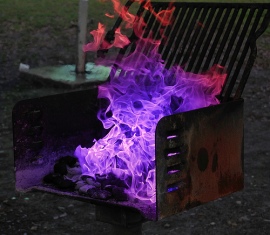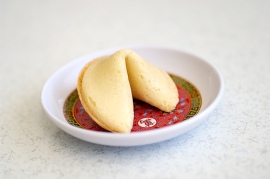Chef Delaney's Cutting Board
Just another WordPress.com weblogArchive for December, 2009
Barbecue – Who gets the credit?
 Barbecue – A word that has become synonymous with smoky sauces, backyard pool parties, tail-gating and those quirky “Kiss The Chef” aprons. When most people hear the word Barbecue, they see an image of the suburbanite baby-boomer stacking Kingsford briquettes into his Weber, lighting it up and burning a pack of Ballparks… the typical nuclear family of the fifties.
Barbecue – A word that has become synonymous with smoky sauces, backyard pool parties, tail-gating and those quirky “Kiss The Chef” aprons. When most people hear the word Barbecue, they see an image of the suburbanite baby-boomer stacking Kingsford briquettes into his Weber, lighting it up and burning a pack of Ballparks… the typical nuclear family of the fifties.
Ask any good cook though, and they may tell you about the sweet vinegar based sauce that makes North Carolina pulled-pork so tasty. Or perhaps they’ll rave about the way you can cut a slow-smoked Texas brisket with a plastic spoon. Some will sing the praises of the dry-rubbed Memphis BBQ and extoll the virtues of adding the sauce (mopping) at the very end. Even more may brag about the mustardy tang of a traditional northeast deep-pit beef BBQ. Whatever the story may be, most people agree that barbecue means American.
And now for a pre-history lesson. Barbecue contains two key elements – meat and fire (something the cave-men were doing long before tail-fins on Cadillacs and the Donna Reed Show).
Because pre-modern man figured out early on that roasting meat over a fire not only reduced the likelihood of illness but actually made food taste better, rising civilizations throughout the globe developed essentially the same style of early cooking – take a piece of meat, subject it to fire and eat it once it gets darker.
The current method of barbecuing is thought to have derived from the Caribbean’s early version of cooking called barabicu, and the current spelling of the word is likely to have been picked up by the first Spanish settlers. Meanwhile, across the Gulf of Mexico, the early Meztesos and South American tribes had their own version of fire-cooking called barbacoa that involved burying a wrapped cut of meat (traditionally goat) in a hole and then building a fire over it to heat up and cook the buried meat. This same cooking style has been found in use everywhere from the Polynesian islands, New Zealand & Australia, parts of Africa, Indonesia, Southeast Asia, China and variations of early “deep-pit” barbecue can be found virtually anywhere meat is consumed.
So, if barbecue developed simultaneously throughout the world, who gets the credit? The correct answer is… there is no correct answer! The general concensus is that the latin-american barbacoa was the first recognized form of fire-cooking but, though they were historically the first culture to be recognized “q-ers”, cave drawings have proven otherwise.
Whatever the case may be, barbecue takes us back to our primal element – back to the time when our only fear was being eaten by a saber-toothed tiger. I take comfort knowing that barbecue has lasted through the ages. It’s good to know that one day my great-great-great-great-grandchildren will be consuming meat that’s been cooked with fire. I’m just hoping someone will still be passing along my famous Smoked Peach & Chipotle BBQ Sauce recipe…
What the hell IS figgy pudding anyways?!
Allright… yippee-freakin-yay… It’s that time of the year when all my favorite radio stations break out the Christmas music and play it non-stop. Now don’t get me wrong – I’m all for Christmas music. I just hate it when I’m subjected to it when I should be listening to something actually worth listening to. I guess I might just have to break down and get that ipod docking station before next Christmas…
One song that seems to be played to death is ‘We wish you a merry Christmas.’ It’s a fine song but it gets old fast. However, there is one line that always makes me scratch my neanderthal-ish head. “Bring us some figgy-pudding.” Never mind that they’re putting demands on their host… I mean refusing to leave until they get some?! What are they, Royalty?! And the REAL question, of course is
What the hell IS figgy pudding anyways?!
This was driving me nuts so I did what any good journalist would do and googled it. It turns out that figgy pudding is actually more of a steamed cake than a custard and takes more than three hours to cook. I guess those guests are planning to stay awhile…
Figgy pudding is an English dessert recipe that was developed in the fifteenth century and was a popular Christmas menu item. The name is misleading though as figgy pudding may or may NOT contain figs and was often times made with carrots instead. Several variations of the ancient recipe exist but a common element is the steaming method used to cook it. Typically, the batter would be put into a cast-iron kettle that was then placed inside a bigger kettle with a cushion of water between the two (think bain-marie). Then, both kettles were covered tightly with a cloth soaked in creme and placed over a low fire to cook. The cloth would have to be splashed with creme at regular intervals to avoid scorching and the fire would have to be just hot enough to not burn the bottom of the mixture. After three hours or so the kettle would be removed and allowed to cool and would usually be served in a bowl and sprinkled with cinnamon and/or nutmeg. Almost like a medieval bread pudding…
On my quest of figgy pudding enlightenment, I ran across tons of recipes that tried to stay true to the original cooking technique but seeing that I have niether a pot-au-fue kettle or a fire-pit in my kitchen, I decided to tweak the recipe a bit and make it more approachable for today’s home cook. I DID stay true to the ingredients (though suet is not the easiest thing to find). So now that the mystery of figgy pudding is solved, here’s an easy adaptation for you to try this Christmas. Cooking time is still a bit long so you may want to make it a day in advance but mine turned out pretty tasty actually…
Christmas Figgy Pudding
Ingredients:
– ½ cup salted butter or suet (kidney fat)
– 1 cup molasses
– 6 whole eggs
– 2 cups finely minced sugar figs
– 1 cup crème fraiche or buttermilk
– ½ cup chopped walnuts
– ¼ cup pureed carrots
– 3 cups sifted flour
– ½ tsp baking soda
– 1 tsp lemon zest
– ¼ tsp cinnamon
– ¼ tsp nutmeg
In a large mixing bowl, beat the eggs and crème fraiche (or buttermilk) together until fully incorporated. Beat in the butter (or suet), carrot puree, walnuts, figs, cinnamon, nutmeg and lemon zest. In a separate bowl, sift the flour and baking soda together. Fold the flour mixture into the egg mixture and mix until fully incorporated. Fold in the molasses taking care not to over-mix (you want the molasses to be “marbled” through the batter). Spoon the mixture into a greased and floured 7” x 11” glass baking dish. Place the dish into a 9” x 13” glass baking dish and fill the space between the two pans almost to the top with cold water. Tightly wrap the entire set-up with tented heavy-duty foil and cook on the top rack of a 225 degree oven for about 1 ½ hour. Allow to cool and serve.
There you have it folks. Chef Delaney signing off for the weekend but if you have a burning desire to talk to me, hit me up on facebook and become a fan!
Let’s Get Cooking!
Hello and Welcome to the Cutting Board!
My name is Chef Delaney and yes… I’m an actual Chef. I’ve been cooking for more than 14 years and along the way have picked up a lot of really cool tricks and recipes. My plan is to pass them along to you. Unlike other cooking blogs out there, this site offers more than just recipes. I have stories about working in the kitchens that would give Stephen King nightmares. I have shopping tips that will save you a ton. I have storage tips. Garnishing tips. Plating tips. Serving tips. Bartending tips. I’ll even give you tips about your love-life if you ask. Speaking of asking, this site is designed to be interactive. If you have questions, I’ll answer ’em! If you want to upload pictures of your cooking, I’ll post ’em! If you just want to say ‘Hello’, guess what? I’m gonna say ‘Hello’ back! Besides, what other cooking site plays rock music when you open it?
I’m looking forward to really kicking this thing off so stay tuned…
